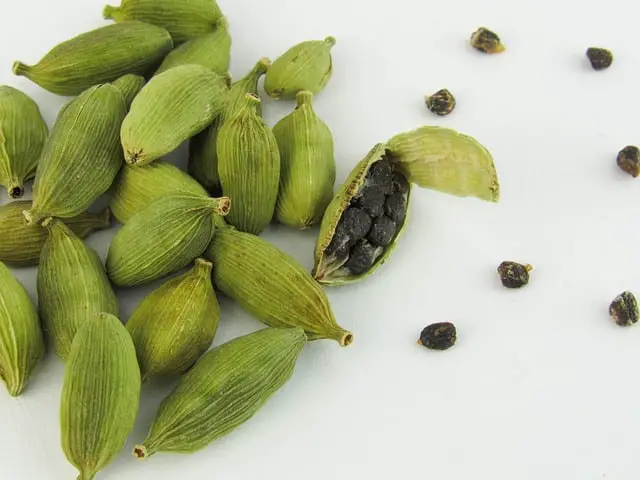Cardamom is a highly prized spice known for its aromatic and versatile qualities. Cardamom pods are the whole seed capsules, encapsulating tiny black seeds, and are used in dishes where the entire spice pod can be removed before serving. Ground cardamom, on the other hand, is a convenient form of this spice, offering the same unique flavor but in a powdered form.
What makes cardamom exceptional in cooking is its ability to straddle the line between sweet and savory. It adds a complex, citrusy, and slightly minty flavor to dishes, enhancing both desserts and savory creations. Whether used whole or ground, cardamom’s versatility and delightful aroma make it a favorite spice for elevating a wide range of culinary delights.
Here are the key differences between cardamom pods and ground cardamom.
Cardamom Pods
- Form: Cardamom pods are the seed pods of the cardamom plant (Elettaria cardamomum). They are small, green, and elongated.
- Flavor and Aroma: Cardamom pods have a fresher, more aromatic flavor compared to ground cardamom. They offer a complex combination of citrus, herbal, and slightly floral notes.
- Usage: They are typically used in recipes that require longer cooking times, like stews, curries, or rice dishes, where the pods can infuse their flavor slowly.
- Preparation: To use cardamom pods, you typically crush them slightly or split them open to release the seeds inside. These seeds can be used whole or ground. Click here to read about how many seeds are typically in one cardamom pod along with suggested uses.
Ground Cardamom
- Form: Ground cardamom is made by grinding the small seeds found inside cardamom pods. It is a fine powder and is more convenient for quick and easy use.
- Flavor and Aroma: Ground cardamom has a slightly milder and more uniform flavor compared to cardamom pods. It retains the characteristic citrusy and herbal notes but may lose some of the freshness over time.
- Usage: Ground cardamom is ideal for recipes where even distribution of flavor is important, such as baking, desserts, and spice blends. It’s also easier to incorporate into liquids.
- Convenience: Ground cardamom is more convenient, as it doesn’t require the extra step of cracking open pods and removing the seeds. It can be used directly in recipes.
- Storage: Ground cardamom tends to lose its flavor and aroma faster than whole pods. It’s best to store it in an airtight container away from light and heat.
In summary, cardamom pods are preferred for dishes that benefit from the slow infusion of their complex flavor, while ground cardamom is convenient for recipes where an even distribution of flavor is essential, such as baking. Both forms have their unique advantages and can be chosen based on your specific cooking needs.
How To Use Cardamom Pods And Ground Cardamom
Here are some dishes and uses for both cardamom pods and ground cardamom:
Cardamom Pods
- Chai Tea: Cardamom pods are a key ingredient in chai tea. They add a warm, aromatic flavor to the brew.
- Curries: Cardamom pods are often used in Indian and Middle Eastern curries. They infuse the dish with a subtle, citrusy aroma.
- Biryani: Whole cardamom pods are commonly added to biryani, a fragrant rice dish, to impart their flavor during the slow cooking process.
- Stews: They can be added to savory stews and slow-cooked meat dishes to enhance the overall flavor profile.
- Rice Dishes: Cardamom pods can be added to rice dishes, like pilaf or pulao, to impart a delicate fragrance.
- Infused Syrups: They are used to infuse syrups for desserts, cocktails, or flavored beverages.
Ground Cardamom
- Baking: Ground cardamom is a staple in baking. It’s used in cookies, cakes, muffins, and bread to add a unique flavor.
- Desserts: Ground cardamom can be added to rice puddings, custards, and ice creams for a sweet and aromatic twist.
- Spice Blends: Ground cardamom is a key ingredient in various spice blends, such as garam masala, pumpkin pie spice, and ras el hanout.
- Coffee: A pinch of ground cardamom can be added to coffee grounds before brewing for a fragrant cup of spiced coffee.
- Smoothies: Ground cardamom pairs well with fruits like bananas and apples in smoothies, adding an exotic touch.
- Homemade Bread: It can be incorporated into homemade bread recipes for a unique flavor in each slice.
- Flavored Yogurt: Stir ground cardamom into yogurt along with honey and chopped nuts for a flavorful and aromatic yogurt topping.
Remember that cardamom is a versatile spice that can be used in both sweet and savory dishes, so don’t hesitate to experiment and discover your favorite uses.
Final Thoughts
The main differences between cardamom pods and ground cardamom are:
- Form: Cardamom pods are the whole seeds still encapsulated in their papery hulls. Ground cardamom has been processed by grinding the seeds, removing the papery hulls.
- Flavor intensity: Ground cardamom has a stronger, more concentrated flavor since the seeds have been ground into a powder. Cardamom pods need to be crushed or used in dishes where they can steep and release flavor.
- Uses: Cardamom pods are often used whole in dishes where their flavor needs to infuse slowly, like rice pilafs, braised meats, etc. Ground cardamom lends itself to baked goods, curries, teas where intense flavor is desired.
- Shelf life: Ground cardamom only retains maximum flavor for 6-12 months, after which it loses potency. Cardamom pods will maintain quality for 2-3 years when stored properly.
- Aroma: The papery pods help protect the volatile essential oils responsible for cardamom’s distinct, sweet-yet-fragrant aroma. Ground cardamom aroma escapes more quickly.
- Cost: Cardamom pods usually cost less than pre-ground since no processing is involved. But ground is more convenient.
So in summary, cardamom pods maintain freshness longer but must be crushed or steeped; ground cardamom provides instant intensity but don’t last as long.

